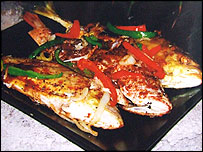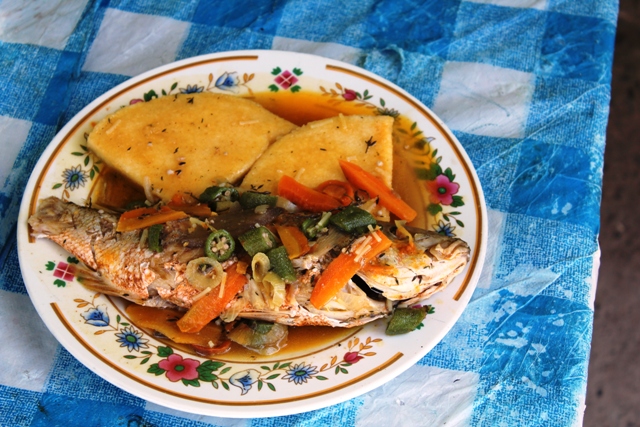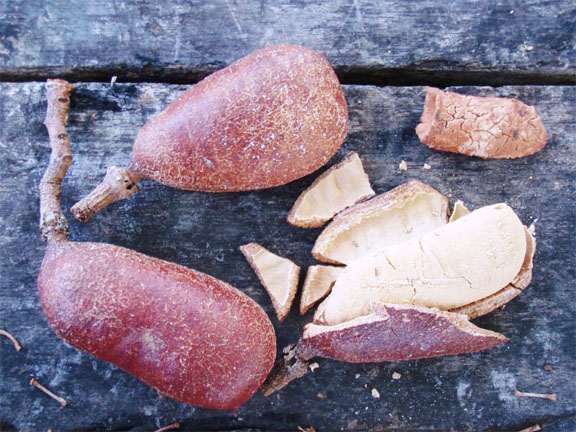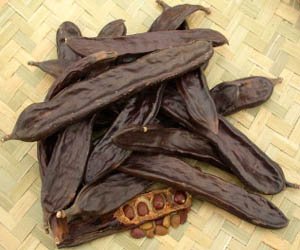Locust
(From International Standard Bible Encyclopedia)
lo'-kust: The translation of a large number of Hebrew and Greek words:
1. Names:
(1) 'arbeh from the root rabhah, "to increase" (compare Arabic raba', "to increase"). (2) sal'am, from obsolete [?] cal'am, "to swallow down," "to consume." (3) chargol (compare Arabic charjal, "to run to the right or left," charjalat, "a company of horses" or "a swarm of locusts," charjawan, a kind of locust). (4) chaghabh (compare Arabic chajab, "to hide," "to cover"). (5) gazam (compare Arabic jazum, " to cut off") (6) yeleq, from the root laqaq "to lick" (compare Arabic laqlaq, "to dart out the tongue" (used of a serpent)). (7) chacil, from the root chacal, "to devour" (compare Arabic chaucal, "crop" (of a bird)). (8) gobh, from the obsolete root gabhah (compare Arabic jabi, "locust," from the root jaba', "to come out of a hole"). (9) gebh, from same root. (10) tselatsal from [?] tsalal (onomatopoetic), "to tinkle," "to ring" (compare Arabic call, "to give a ringing sound" (used of a horse's bit); compare also Arabic Tann, used of the sound of a drum or piece of metal, also of the humming of flies). (11) akris (genitive akridos; diminutive akridion, whence Acridium, a genus of locusts).
2. Identifications:
(1), (2), (3) and (4) constitute the list of clean insects in Leviticus 11:21 f., characterized as "winged creeping things that go upon all fours, which have legs above their feet, wherewith to leap upon the earth." This manifestly refers to jumping insects of the order Orthoptera, such as locusts, grasshoppers and crickets, and is in contrast to the unclean "winged creeping things that go upon all fours," which may be taken to denote running Orthoptera, such as cockroaches, mole-crickets and ear-wigs, as well as insects of other orders.
'Arbeh (1) is uniformly translated "locust" in the Revised Version (British and American). the King James Version has usually "locust," but "grasshopper" in Judges 6:5; Judges 7:12; Job 39:20; Jeremiah 46:23. Septuagint has usually akris, "locust"; but has brouchos, "wingless locust," in Leviticus 11:22; I Kings 8:37 (akris in the parallel passage, II Chronicles 6:28); Nahum 3:15; and attelebos, "wingless locust," in Nahum 3:17. 'Arbeh occurs (Exo. 10:4-19) in the account of the plague of locusts; in the phrase "as locusts for multitude" (Judges 6:5; Judges 7:12); "more than the locusts .... innumerable" (Jeremiah 46:23);
"The locusts have no king,
Yet go they forth all of them by bands" (Proverbs 30:27).
'Arbeh is referred to as a plague in Deuteronomy 28:38; I Kings 8:37; II Chronicles 6:28; Psalms 78:46; in Joel and in Nahum. These references, together with the fact that it is the most used word, occurring 24 times, warrant us in assuming it to be one of the swarming species, i.e. Pachtylus migratorius or Schistocerca peregrina, which from time to time devastate large regions in the countries bordering on the Mediterranean.
Cal'am (2), English Versions of the Bible "bald locust," occurs only in Leviticus 11:22. According to Tristram, NBH, the name "bald locust" was given because it is said in the Talmud to have a smooth head. It has been thought to be one of the genus Tryxalis (T. unguiculata or T. nasuta), in which the head is greatly elongated.
Chargol (3), the King James Version "beetle," the Revised Version (British and American) "cricket," being one of the leaping insects, cannot be a beetle. It might be a cricket, but comparison with the Arabic (see supra) favors a locust of some sort. The word occurs only in Leviticus 11:22.
See BEETLE.
Haghabh (4) is one of the clean leaping insects of Leviticus 11:22 (English Versions of the Bible "grasshopper"). The word occurs in four other places, nowhere coupled with the name of another insect. In the report of the spies (Numbers 13:33), we have the expression, "We were in our own sight as grasshoppers"; in Ecclesiastes 12:5, "The grasshopper shall be a burden"; in Isaiah 40:22, "It is he that sitteth above the circle of the earth, and the inhabitants thereof are as grasshoppers." These three passages distinctly favor the rendering "grasshopper" of the English Versions of the Bible. In the remaining passage (II Chronicles 7:13), ".... if I command the locust (English Versions) to devour the land," the migratory locust seems to be referred to. Doubtless this as well as other words was loosely used. In English there is no sharp distinction between the words "grasshopper" and "locust."
The migratory locusts belong to the family Acridiidae, distinguished by short, thick antennae, and by having the organs of hearing at the base of the abdomen. The insects of the family Locustidae are commonly called "grasshoppers," but the same name is applied to those Acridiidae which are not found in swarms. The Locustidae have long, thin antennae, organs of hearing on the tibiae of the front legs, and the females have long ovipositors. It may be noted that the insect known in America as the seventeen-year locust, which occasionally does extensive damage to trees by laying its eggs in the twigs, is a totally different insect, being a Cicada of the order Rhynchota. Species of Cicada are found in Palestine, but are not considered harmful.
The Book of Joel is largely occupied with the description of a plague of locusts. Commentators differ as to whether it should be interpreted literally or allegorically (see JOEL). Four names 'arbeh (1), gazam (5), yeleq (6) and chacil (7), are found in Joel 1:4 and again in Joel 2:25.
Gobh (8) is found in the difficult passage (Amos 7:1), ".... He formed locusts (the King James Version "grasshoppers," the King James Version margin "green worms," Septuagint akris) in the beginning of the shooting up of the latter growth"; and (Nahum 3:17) in ".... thy marshals (are) as the swarms of grasshoppers (Hebrew gobh gobhay; the King James Version "great grasshoppers"), which encamp in the hedges in the cold day, but when the sun ariseth they flee away, and their place is not known where they are." The related gebh (9) occurs but once, in Isaiah 33:4, also a disputed passage, "And your spoil shall be gathered as the caterpillar (chacil) gathereth: as locusts (gebhim) leap shall men leap upon it." It is impossible to determine what species is meant, but some kind of locust or grasshopper fits any of these passages.
In Deuteronomy 28:42, "All thy trees and the fruit of thy ground shall the locust (English Versions of the Bible) possess," we have (10) tselatsal, Septuagint erusibe). The same word is translated in II Samuel 6:5 and Psalms 150:5 bis "cymbals," in Job 41:7 "fish-spears," and in Isaiah 18:1 "rustling." As stated in 1, above, it is an onomatopoetic word, and in Deuteronomy 28:42 may well refer to the noise of the wings of a flight of locusts. In the New Testament we have (11) akris, "locust," the food of John the Baptist (Matthew 3:4; Mark 1:6); the same word is used figuratively in Revelation 9:3, Revelation 9:1; and also in the Apocrypha (Judith 2:20; The Wisdom of Solomon 16:9; and see 2 Esdras 4:24).










